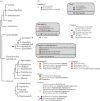The evolution of organellar metabolism in unicellular eukaryotes
- PMID: 20124338
- PMCID: PMC2817233
- DOI: 10.1098/rstb.2009.0260
The evolution of organellar metabolism in unicellular eukaryotes
Abstract
Metabolic innovation has facilitated the radiation of microbes into almost every niche environment on the Earth, and over geological time scales transformed the planet on which we live. A notable example of innovation is the evolution of oxygenic photosynthesis which was a prelude to the gradual transformation of an anoxic Earth into a world with oxygenated oceans and an oxygen-rich atmosphere capable of supporting complex multicellular organisms. The influence of microbial innovation on the Earth's history and the timing of pivotal events have been addressed in other recent themed editions of Philosophical Transactions of Royal Society B (Cavalier-Smith et al. 2006; Bendall et al. 2008). In this issue, our contributors provide a timely history of metabolic innovation and adaptation within unicellular eukaryotes. In eukaryotes, diverse metabolic portfolios are compartmentalized across multiple membrane-bounded compartments (or organelles). However, as a consequence of pathway retargeting, organelle degeneration or novel endosymbiotic associations, the metabolic repertoires of protists often differ extensively from classic textbook descriptions of intermediary metabolism. These differences are often important in the context of niche adaptation or the structure of microbial communities. Fundamentally interesting in its own right, the biochemical, cell biological and phylogenomic investigation of organellar metabolism also has wider relevance. For instance, in some pathogens, notably those causing some of the most significant tropical diseases, including malaria, unusual organellar metabolism provides important new drug targets. Moreover, the study of organellar metabolism in protists continues to provide critical insight into our understanding of eukaryotic evolution.
Figures

References
-
- Atteia A., van Lis R., Gelius-Dietrich G., Adrait A., Garin J., Joyard J., Rolland N., Martin W.2006Pyruvate formate-lyase and a novel route of eukaryotic ATP synthesis in Chlamydomonas mitochondria. J. Biol. Chem. 281, 9909–9918 (doi:10.1074/jbc.M507862200) - DOI - PubMed
-
- Barbrook A. C., Howe C. J., Kurniawan D. P., Tarr S. J.2010Organisation and expression of organellar genomes. Phil. Trans. R. Soc. B 365, 785–797 (doi:10.1098/rstb.2009.0250) - DOI - PMC - PubMed
-
- Bendall D. S., Howe C. J., Nisbet E. G., Nisbet R. E.2008Photosynthetic and atmospheric evolution. Introduction. Phil. Trans. R. Soc. B 363, 2625–2628 (doi:10.1098/rstb.2008.0058) - DOI - PMC - PubMed
-
- Burki F., Shalchian-Tabrizi K., Pawlowski J.2008Phylogenomics reveals a new ‘megagroup’ including most photosynthetic eukaryotes. Biol. Lett. 4, 366–369 (doi:10.1098/rsbl.2008.0224) - DOI - PMC - PubMed
-
- Cavalier-Smith T.2009Predation and eukaryote cell origins: a coevolutionary perspective. Int. J. Biochem. Cell Biol. 41, 307–322 (doi:10.1016/j.biocel.2008.10.002) - DOI - PubMed
Publication types
MeSH terms
Grants and funding
LinkOut - more resources
Full Text Sources

